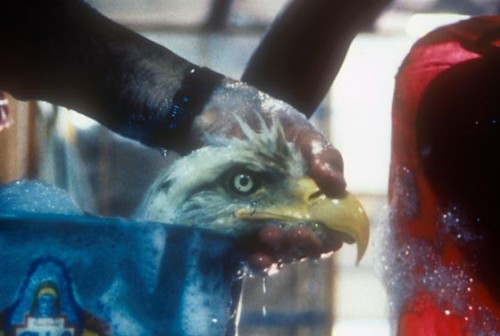Two decades after the Exxon Valdez oil tanker struck an iceberg and spilt millions of litres of oil into the delicate Arctic environment, governments and industry in the region remain unprepared to deal with another such disaster, according to a new analysis by WWF.
With restrictions on oil and gas development lifted and increased activity making accidents more likely, the global environment group distributed rocks from Alaska’s Prince William Sound, still crusted with oil from the accident on 24 March 1989.
The rocks, together with a call for oil and gas no-go areas over sensitive Arctic environments and some of the world’s richest fishing grounds, were sent to ministers, officials and media in the Arctic countries still wrangling over arrangements to govern a renewed resource rush to the area.
“While there has been little improvement in technologies to respond to oil spill disasters in the last 20 years, the Arctic itself has changed considerably and is much more vulnerable today,†said Neil Hamilton, leader of WWF’s Arctic Program.
“Sea ice is disappearing and open water seasons are lasting longer, creating a frenzy to stake claims on the Arctic’s rich resources – especially oil and gas development. Oil spills can be devastating to Arctic marine environments and given the current lack of oil spill response capabilities, we need a ‘timeout’ until protective measures exist for this fragile, special place.â€
The report, Lessons Not Learned, recommends a moratorium on new offshore oil development in the Arctic until technologies improve to a point where an adequate oil-spill clean-up operation could be performed.
WWF also recommends that the most vulnerable and important areas of the Arctic be deemed permanently off-limits to oil development.
Such “no-go zones†should be based on the sensitivity and productivity of special priority areas where oil spill response would be next to impossible to clean up or where any spill would cause irreparable long-term damage.
These areas include Bristol Bay in Alaska, America’s fish basket accounting for 40 per cent of the national catch; the Lofoten-Vesteralen area in Norway; and the West Kamchatka Shelf in Russia. In all of these places WWF, with the largest global Arctic conservation program, has teamed up with local people who also oppose the threat oil development poses to rich fishing grounds.
Lessons Not Learned recommends that all Arctic countries conduct comprehensive risk assessments that include industrial activities, shipping, petroleum development and anticipated impacts of climate change.
“Arctic countries should also adopt a comprehensive agreement for any accident and spill response that is Arctic-wide, has needed facilities in place and provides for joint action between countries,†Hamilton said.
“The Exxon Valdez spill has been the best-studied oil spill in history and scientists have found that even 20 years later, the damage from the spill continues,†said Margaret Williams, managing director of WWF’s Alaska program.
“Fishermen’s livelihoods were destroyed, many wildlife and fish populations still haven’t recovered and the Alaskan economy lost billions of dollars. We can’t let that happen in Bristol Bay or anywhere else in the Arctic.â€
